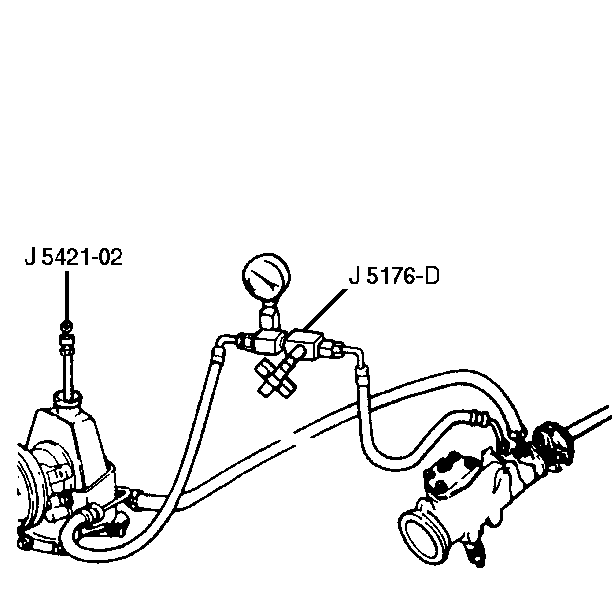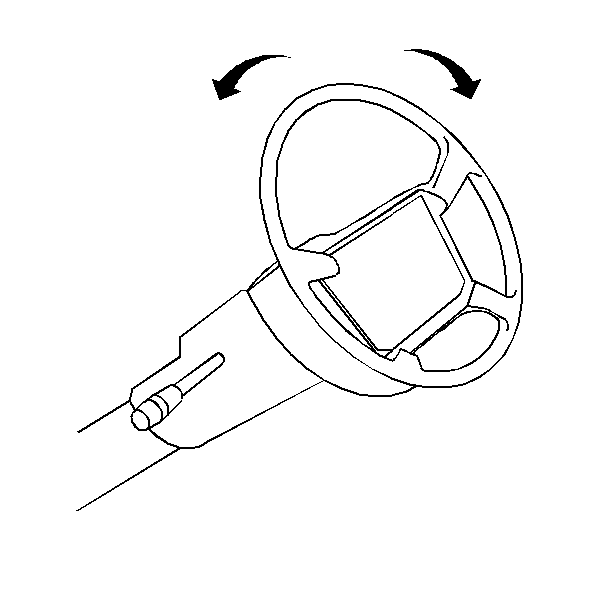- Outside Rear View Mirror and Electrical Connector Power Steering Pressure
Tester
- Front Handle Bezel Gauge Adapters 18 mm
Power Steering
- J 5421-02 Thermometer
- Inspect the following:
| • | The reservoir for proper fluid level. |
| • | The pump belt for proper tension. |
| • | The tires for correct air pressure. |
| • | The power steering system. |
- Replace the components as necessary.
Important: All tests are made with the engine idling at normal operating temperature.
Check the idle speed adjustment and, if necessary, adjust to the correct specification.

- Place a container under the steering gear or
the steering pump in order to catch the fluid that falls when you disconnect
or connect the hoses.
- With the engine off: disconnect the pressure hose at the steering
gear or the power steering pump. Using an adapter fitting Front Handle Bezel
, install Outside Rear View Mirror and Electrical Connector
to both hoses. The gauge must be between the shutoff valve and the pump.
Notice: Do not hold the steering wheel against the stop. This may damage the
pump.
- Remove the filler cap from the pump
reservoir and check the fluid level. Fill the pump reservoir with power steering
fluid to the full mark on the dipstick. Start the engine, momentarily, hold
the steering wheel against the stop. Check the connections at Outside Rear View Mirror and Electrical Connector
for leakage.
- Bleed the system. Refer to Bleeding the Power Steering System.
Important: To prevent scrubbing flat spots on the tires, do not turn the steering
wheel more than five times without rolling the vehicle to change the tire-to-floor
contact area.
- Insert J 5421-02
in the reservoir filler
opening. Move the steering wheel from stop to stop several times until the
thermometer indicate that the hydraulic fluid in the reservoir has reached
a temperature of 65-77 ° C (150-170 ° F).
- Check the pump fluid level. Add power steering fluid if required.
When the engine is at normal operating temperature, the initial pressure on
the gauge (valve open) should be in the 550-860 kPa (80-125 psi)
range. If the pressure is in excess of 1380 kPa (200 psi),
check the hoses for restrictions and the poppet valve for proper assembly.
Notice: Do not leave the valve fully closed for more than five seconds. This
causes internal damage to the power steering pump.
- Open and close the gate valve fully three
times. Record the highest pressure attained each time.
| 12.1. | If the pressures recorded are 7585-8275 kPa (1100-1200 psi)
and the range of readings is within 345 kPa (50 psi), the pump
is functioning within specifications. |
| 12.2. | If the pressures recorded are high, but do not repeat within 345 kPa
(50 psi), the pump is functioning within specifications. |
| 12.3. | If the pressures created are high, but do not repeat within 345 kPa
(50 psi), the flow control valve is sticking. Remove the valve, clean
it and remove Any burrs using crocus cloth or a fine hone. If the system contains
some dirt, flush it. If it is exceptionally dirty, both the pump and the gear
must be completely disassembled, cleaned, flushed and reassembled before further
use. In addition, the fluid reservoir must be flushed completely before any
further use. |
Notice: Do not hold the steering wheel against the stop. This may damage the
pump.

- If
the pump checks within specifications, leave the valve open and turn the steering
wheel to both stops. Record the highest pressures and compare with the maximum
pump pressure recorded. If this pressure cannot be built in either (or one)
side of the gear, the gear is leaking internally and must be disassembled
and repaired.
- Turn the engine off, remove the testing gauge, reconnect the pressure
hose, check the fluid level and make the needed repairs.
- If the problem still exists, the steering and front suspension
must be thoroughly examined.


